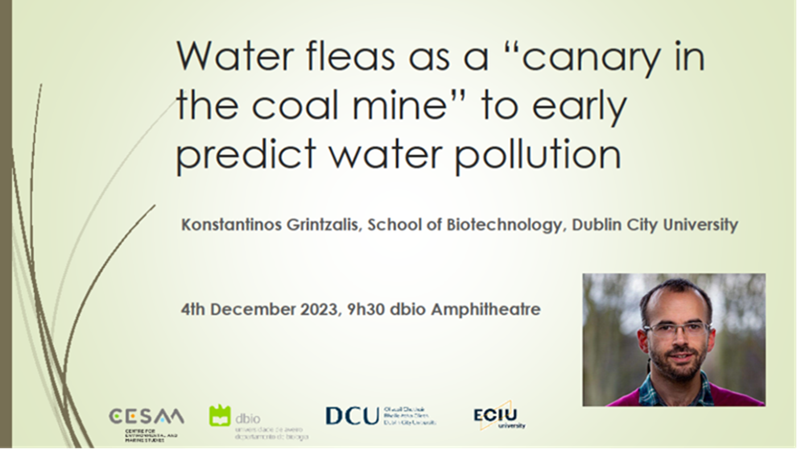
On December 4th, at 9:30 AM, Amphitheater 8.1.43 of the Department of Biology at the University of Aveiro will host a lecture on the use of water fleas as early indicators of water pollution. The specialist Konstantinos Grintzalis from the School of Biotechnology at Dublin City University will lead the presentation.
The growing human population has a significant impact on the environment and the “health” of the planet. Therefore, assessment of environmental exposure to toxic chemicals and their impact on biological systems is important. Currently most approaches focus on the detection of chemicals or monitoring the abundance of fauna and flora. However, these measurements are weak in terms of providing minimal detection of possible contaminants in the environment, while they also fail to produce a diagnostic insight concerning the type of stressor. Furthermore, these methods cannot predict any future impact before ecological damage has occurred and this is reflected in the poor legislation in some cases of pollutants, which comes as a natural consequence of them not being able to safeguard the environment. Moving away from traditional methods to monitor pollution, modern eco-toxicology is shifting towards the use of effect-based methods as key approaches to supplement and provide meaningful mechanistic insight for pollution assessment. Focusing on the freshwater ecosystem, daphnids, commonly known as water fleas, have acquired a central position in molecular ecology and ecotoxicology. Exposing daphnids in a series of pollutants and generating molecular fingerprints from their responses allows a more in depth understanding for the action of pollutants in non-target species. Holistic metabolomic approaches define the molecular changes of several chemicals and novel materials in the physiology of daphnids for individual and mixtures of stressors. Comparing these “signatures” with the ones obtained from actual water samples, elevate daphnids as an equivalent to “a canary in the coal mine” to early predict pollution and provide new metrics for water quality.
Biographical Note:
Konstantinos Grintzalis is a biologist and has focused in biochemistry and metabolism by training. He did all hist undergraduate and postgraduate studies in Greece, in the University of Patras, and his first postoc in fungal metabolomics and systems biology in the Institute of Chemical Engineering in Patras. Following he moved to Belgium in the Louvain Institute of Biomolecular Science and Technology of Université catholique de Louvain and worked in cell nanotoxicology. Following, he started his research in molecular ecotoxicology with daphnids and metabolomics, working with pioneers in the field such as Mark Viant in the University of Birmingham. In 2017, he got his first academic position in Dublin City University as assistant professor and later excelled with funding acquisition and his tenure, where he leads a research group in metabolomics and molecular toxicology. His research expands from toxicology, astrobiology, oxidative stress and metabolomics to many areas and questions. Today he will be presenting how daphnids are used as bioindicators to predict and understand pollution.